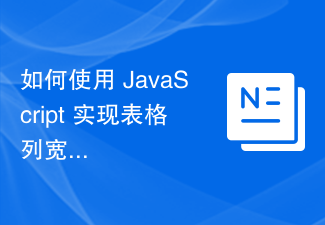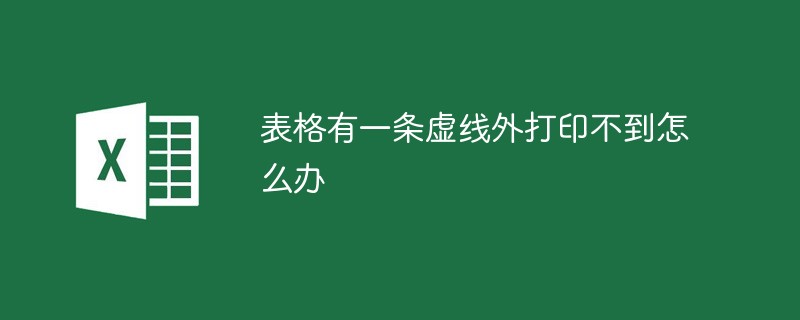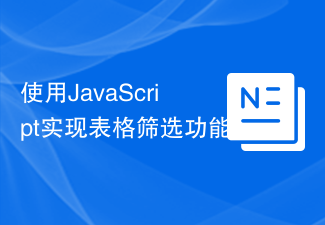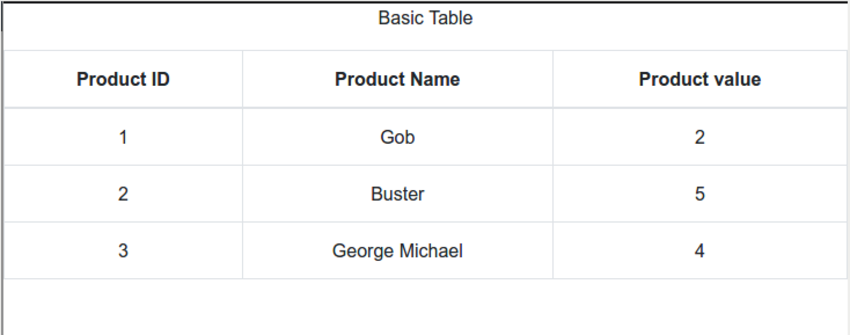We know that Dreamweaver has done an excellent job in making tables, but at some point it still has to be combined with CSS to achieve some specific effects. Let’s first sort out the CSS syntax for table borders, and then introduce how to use CSS to beautify it. The border of the table.
CSS syntax for table borders
Specific contents include: top border width, right border width, bottom border width, left border width, Border width, border color, border style, top border, bottom border, left border, right border, border, width, height, related labels, etc.
1. Top border width
Syntax: border-top-width:
Allowed values: thin | medium | thick |
Initial value: medium
Applicable to: all objects
Backward compatibility: no
Top border width property is used Specifies the width of an element's top border. The value can be one of three keywords, none of which are affected by font size or length, and can be used to implement proportional widths. Negative values are not allowed. It can also be used to abbreviate the top border, the width of the border, or the properties of the border.
2. Right border width
Syntax: border-right-width:
Allowed values: thin | medium | thick |
Initial value: medium
Applicable to: all objects
Backward compatibility: no
The right border width property is used for Specifies the width of the element's right border. The value can be one of three keywords, none of which are affected by font size or length, and can be used to implement proportional widths. Negative values are not allowed. Can also be used to abbreviate the right border, border width, or border properties.
3. Bottom border width
Syntax: border-bottom-width:
Allowed values: thin | medium | thick |
Initial value: medium
Applicable to: all objects
Backward compatibility: no
The bottom border width attribute is used Specifies the width of the element's bottom border. The value can be one of three keywords, none of which are affected by font size or length, and can be used to implement proportional widths. Negative values are not allowed. It can also be used to abbreviate the bottom border, the width of the border, or the properties of the border.
4. Left border width
Syntax: border-left-width:
Allowed values: thin | medium | thick |
Initial value: medium
Applicable to: all objects
Backwards compatible: no
The left border width property is used for Specifies the width of the element's left border. The value can be one of three keywords, none of which are affected by font size or length, and can be used to implement proportional widths. Negative values are not allowed. It can also be used to abbreviate the left border, the width of the border, or the properties of the border.
5. Border width
Syntax: border-width:
Allowed values: [ thin | medium | thick | < ;Length> ]{1,4}
Initial value: undefined
Applicable to: all objects
Backward compatibility: No
Border The width attribute sets the bounds of an element with one to four values, where the value is a keyword or length. Negative lengths are not allowed. If all four values are given, they apply to the top, right, bottom, and left border styles respectively. If a value is given, it will be applied to each edge. If two or three values are given, the omitted value is equal to the opposite side. This property is shorthand for the top, right, bottom, and left properties. You can also use the abbreviated border attribute.
6. Border color
Syntax: border-color:
Allowed values:
Initial value: the value of the color attribute
Applicable to: all objects
Backward compatibility: No
The border color attribute sets the value of an element Border color. You can use one to four keywords. If all four values are given, they apply to the top, right, bottom, and left border styles respectively. If a value is given, it will be applied to each edge. If two or three values are given, the omitted value is equal to the opposite side. You can also use the abbreviated border attribute.
7. Border style
Syntax: border-style:
Allowed values: [ none | dotted | dashed | solid | double | groove | ridge | inset | outset ]{1,4}
Initial value: none
Applicable to: all objects
Backward compatibility: No
The border style attribute is used to set the style of an element's border. This property must be used to specify a visible border. You can use one to four keywords. If all four values are given, they apply to the top, right, bottom, and left border styles respectively. If a value is given, it will be applied to each edge. If two or three values are given, the omitted value is equal to the opposite side. You can also use the abbreviated border attribute.
none: no style;
dotted: dotted line;
dashed: dashed line;
solid: solid line;
double: double line;
groove: grooved line;
ridge: ridge;
inset: concave;
outset: convex.
8. Top border
Syntax: border-top:
Allowed values:
Initial Value: Undefined
Applies to: All Objects
Backward Compatibility: No
The border-top attribute is a shorthand for setting the width, style, and color of an element's border. Note that only one border style can be given. You can also use the abbreviated border attribute.
9. Right border
Syntax: border-right:
Allowed values:
Initial Value: Undefined
Applies to: All Objects
Backward Compatibility: No
The right border attribute is a shorthand for setting the width, style, and color of an element's right border. Note that only one border style can be given. You can also use the abbreviated border attribute.
10. Bottom border
Syntax: border-bottom:
Allowed values:
Initial Value: Undefined
Applies to: All Objects
Backward Compatibility: No
The border-bottom property is a shorthand for setting the width, style, and color of an element's bottom border. Note that only one border style can be given. You can also use the abbreviated border attribute.
11. Left border
Syntax: border-left:
Allowed values:
Initial Value: Undefined
Applies to: All Objects
Backward Compatibility: No
The left border attribute is a shorthand for setting the width, style, and color of an element's left border. Note that only one border style can be given. You can also use the abbreviated border attribute.
12. Border
Syntax: border:
Allowed values:
Initial value: Undefined
Applies to: All objects
Backward compatibility: No
Border Properties are shorthand for setting the width, style, and color of an element's border.
Examples of border declarations include:
H2 { border: groove 3em }
A:link { border: solid blue }
A:visited { border: thin dotted #800080 }
A:active { border: thick double red }
The border attribute can only set four kinds of borders; it can only give the width and style of a set of borders. In order to give different values for the four borders of an element, web page creators must use one or more attributes, such as: top border, right border, bottom border, left border, border color, border width, border style, top Border width, right border width, bottom border width, or left border width.
13. Width
Syntax: width:
Allowed values:
Initial value: auto
Applicable to: block-level and replaced elements
Backwards compatibility: No
The initial value of the width attribute is " auto", which is the original width of the element (or the width of the element itself). The percentage refers to the width of the parent element. Negative length values are not allowed.
14. Height
Syntax: height:
Allowed values:
Initial value: auto
Applicable to: block-level and replacement elements
Backwards compatibility: No
The initial value of the height attribute is "auto", which is The original height of the element (there is the height of the element itself). The percentage refers to the width of the parent element. Negative length values are not allowed.
15. Related tags
table: table label, the definition of the entire table style should be placed in table;
td: cell label, the definition of cell style should be placed in td.
 如何使用 JavaScript 实现表格列宽拖拽调整功能?Oct 21, 2023 am 08:14 AM
如何使用 JavaScript 实现表格列宽拖拽调整功能?Oct 21, 2023 am 08:14 AM如何使用JavaScript实现表格列宽拖拽调整功能?随着Web技术的发展,越来越多的数据以表格的形式展示在网页上。然而,有时候表格的列宽并不能满足我们的需求,可能会出现内容溢出或者宽度不足的情况。为了解决这个问题,我们可以使用JavaScript实现表格的列宽拖拽调整功能,使用户可以根据需求自由调整列宽。实现表格列宽拖拽调整功能,需要以下三个主
 css怎么去掉表格重复的边框Sep 29, 2021 pm 06:05 PM
css怎么去掉表格重复的边框Sep 29, 2021 pm 06:05 PM在css中,可以使用border-collapse属性来去掉表格中重复的边框,该属性可以设置表格边框是折叠为单一边框还是分开的,只需要将值设置为collapse即可把重叠的边框合并在一起,成为一个边框,实现单线边框的效果。
 表格有一条虚线外打印不到怎么办Mar 28, 2023 am 11:38 AM
表格有一条虚线外打印不到怎么办Mar 28, 2023 am 11:38 AM表格有一条虚线外打印不到的解决办法:1、打开excel文件,在打开的页面中点击“打印”;2、在预览页找到“无缩放”,选择调整为一页;3、选择打印机打印文档即可。
 Vue中如何实现表格数据的导出和导入Oct 15, 2023 am 08:30 AM
Vue中如何实现表格数据的导出和导入Oct 15, 2023 am 08:30 AMVue中如何实现表格数据的导出和导入,需要具体代码示例在使用Vue开发的Web项目中,经常会遇到需要将表格数据导出为Excel或导入Excel文件的需求。本文将介绍如何使用Vue来实现表格数据的导出和导入功能,并提供具体的代码示例。一、表格数据的导出安装依赖首先,我们需要安装一些依赖,用于导出Excel文件。在Vue项目中的命令行中运行以下命令:npmin
 使用JavaScript实现表格筛选功能Aug 10, 2023 pm 09:51 PM
使用JavaScript实现表格筛选功能Aug 10, 2023 pm 09:51 PM使用JavaScript实现表格筛选功能随着互联网技术的不断发展,表格成为了网页中常见的展示数据的方式。然而,当数据量庞大时,用户往往会面临找到特定数据的困难。因此,为表格添加筛选功能,让用户可以快速找到所需的数据,成为了很多网页设计的需求。本文将介绍如何使用JavaScript实现表格筛选功能。首先,我们需要有一份表格数据。下面是一个简单的例子:<t
 如何使用 JavaScript 实现表格分页功能?Oct 20, 2023 pm 06:19 PM
如何使用 JavaScript 实现表格分页功能?Oct 20, 2023 pm 06:19 PM如何使用JavaScript实现表格分页功能?随着互联网的发展,越来越多的网站都会使用表格来展示数据。在一些数据量较大的情况下,需要将数据进行分页展示,以提升用户体验。本文将介绍如何使用JavaScript实现表格分页功能,并提供具体的代码示例。一、HTML结构首先,我们需要准备一个HTML结构来承载表格和分页按钮。我们可以使用<tab
 Vue文档中的表格勾选和全选函数操作方法Jun 20, 2023 pm 10:33 PM
Vue文档中的表格勾选和全选函数操作方法Jun 20, 2023 pm 10:33 PMVue是一种流行的JavaScript框架,它可以让开发人员轻松地构建交互式、响应式的Web界面。Vue框架提供了一系列的组件和指令,用于构建常见的页面元素,如表格、表单、菜单等。在这篇文章中,我们将探讨Vue文档中的表格勾选和全选函数操作方法。在Vue中,我们可以使用v-model指令将表单元素与Vue实例中的数据进行双向绑定。这使得我们可以轻松地收集用户
 React中使用表格:第一部分Sep 04, 2023 pm 07:21 PM
React中使用表格:第一部分Sep 04, 2023 pm 07:21 PM用于呈现数据的最常见的用户界面元素之一是表格。事实证明,使用表格时需要控制很多方面,例如:定义列和标题各种单元格格式(文本、数字、复选框)调整大小过滤动态成长样式在这个由两部分组成的系列中,您将了解使用ReactBootstrapTable组件在React中处理表格数据的细节。您将能够轻松创建复杂且具有专业外观的表格,并且能够自定义各个方面。开始使用 首先,您应该熟悉React本身。如果您需要React入门知识,EnvatoTuts+有一个很棒的系列可以帮助您开始使用React。在本教程中,我们


Hot AI Tools

Undresser.AI Undress
AI-powered app for creating realistic nude photos

AI Clothes Remover
Online AI tool for removing clothes from photos.

Undress AI Tool
Undress images for free

Clothoff.io
AI clothes remover

AI Hentai Generator
Generate AI Hentai for free.

Hot Article

Hot Tools

Atom editor mac version download
The most popular open source editor

VSCode Windows 64-bit Download
A free and powerful IDE editor launched by Microsoft

MinGW - Minimalist GNU for Windows
This project is in the process of being migrated to osdn.net/projects/mingw, you can continue to follow us there. MinGW: A native Windows port of the GNU Compiler Collection (GCC), freely distributable import libraries and header files for building native Windows applications; includes extensions to the MSVC runtime to support C99 functionality. All MinGW software can run on 64-bit Windows platforms.

SublimeText3 Linux new version
SublimeText3 Linux latest version

mPDF
mPDF is a PHP library that can generate PDF files from UTF-8 encoded HTML. The original author, Ian Back, wrote mPDF to output PDF files "on the fly" from his website and handle different languages. It is slower than original scripts like HTML2FPDF and produces larger files when using Unicode fonts, but supports CSS styles etc. and has a lot of enhancements. Supports almost all languages, including RTL (Arabic and Hebrew) and CJK (Chinese, Japanese and Korean). Supports nested block-level elements (such as P, DIV),






